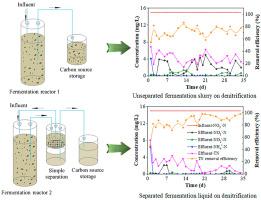Journal of Cleaner Production ( IF 9.7 ) Pub Date : 2020-10-16 , DOI: 10.1016/j.jclepro.2020.124687 Shasha Qi , Shoujun Yuan , Wei Wang , Liwen Xiao , Xinmin Zhan , Zhenhu Hu

|
Food waste fermentation products could be one of cost-effective organic products to replace marketable carbon source for denitrification, whereas the effects of simple separation on food waste fermentation products and its denitrification performance are limited. In this study, the effect of gauze separation on production of food waste fermentation products, denitrification performance, effluent characteristics and activated sludge characteristics were investigated. The total chemical oxygen demand of separated and unseparated fermentation products were 48.0±7.7 g/L and 105.0±11.6 g/L, respectively, and 32% of organic matters in fermentation liquid was in the form of small particles. Lactate and polysaccharide were the dominant organic components in two products. The total nitrogen removal efficiencies with sodium acetate, unseparated fermentation slurry or separated fermentation liquid were 94.8±3.4%, 72.7±7.4% and 88.6±8.1%, respectively. Protein and specific ultraviolet absorbance (SUVA254) in the denitrification reactor with separated fermentation liquid was about 2-4 times lower than unseparated fermentation slurry. Furthermore, Proteobacteria, which is related to denitrification, obviously increased in the denitrification reactor with separated fermentation liquid as carbon source. Therefore, gauze separation can be used to separate food waste fermentation products, and obtain reliable alternative carbon source.
中文翻译:

固液分离对厨余发酵产物作为反硝化外部碳源的影响
食品垃圾发酵产品可能是经济实惠的有机产品之一,可以代替可销毁的可利用碳源,而简单分离对食品垃圾发酵产品及其反硝化性能的影响有限。在这项研究中,研究了纱布分离对食物垃圾发酵产品生产,反硝化性能,污水特性和活性污泥特性的影响。分离和未分离发酵产物的总化学需氧量分别为48.0±7.7 g / L和105.0±11.6 g / L,发酵液中32%的有机物呈小颗粒形式。乳酸和多糖是两种产品中主要的有机成分。醋酸钠的总脱氮效率,未分离的发酵浆液或分离的发酵液分别为94.8±3.4%,72.7±7.4%和88.6±8.1%。蛋白质和特定的紫外线吸收率(SUVA254)在具有分离的发酵液的反硝化反应器中比未分离的发酵浆低约2-4倍。此外,与反硝化有关的变形杆菌在以分离的发酵液为碳源的反硝化反应器中明显增加。因此,纱布分离可用于分离食物垃圾发酵产物,并获得可靠的替代碳源。











































 京公网安备 11010802027423号
京公网安备 11010802027423号